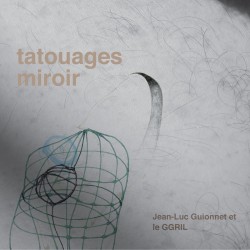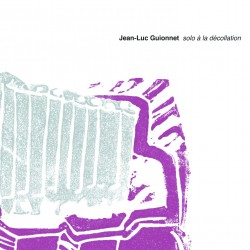Tatouages miroir
Jean-Luc Guionnet et le GGRIL
Tour de Bras tdb90046cd (tourdebras.com)
Solo à la décollation
Jean-Luc Guionnet
Tour de Bras tdb9044cd (tourdebras.com)
 French saxophonist, organist, composer and improviser Jean-Luc Guionnet has rare inventive powers. Among his activities, two bands demonstrate his range: Hubbub, a French quintet, looks like a conventional jazz group while improvising ethereal, symphony-length works of continuous sound through circular breathing on saxophones and bowing on cymbals and the strings of piano and guitar. The international trio Ames Room creates the most singularly intense, hard-bitten, minimalist expression ever developed by a stripped-down trio of saxophone, bass and drums. However, these recordings from Quebec performances show Guionnet’s inventiveness even without his saxophone.
French saxophonist, organist, composer and improviser Jean-Luc Guionnet has rare inventive powers. Among his activities, two bands demonstrate his range: Hubbub, a French quintet, looks like a conventional jazz group while improvising ethereal, symphony-length works of continuous sound through circular breathing on saxophones and bowing on cymbals and the strings of piano and guitar. The international trio Ames Room creates the most singularly intense, hard-bitten, minimalist expression ever developed by a stripped-down trio of saxophone, bass and drums. However, these recordings from Quebec performances show Guionnet’s inventiveness even without his saxophone.
Tatouages miroir (“mirror tattoos”) is an orchestral composition realized by GGRIL (Grand groupe régional d’improvisation libérée), the highly exploratory improvising orchestra that has made Gaspé fertile soil for meaning-probing music. Here GGRIL is an 11-member ensemble of electric guitars and bass, strings, brass and reeds, stretching to include accordion and harp. Beginning with contrasting blasts of orchestral might and silence, the initial lead voice emerges unaccompanied, a tight metallic string sound – the harp – single notes plucked evenly with only microtonal shifts in pitch. In the background, a rich welling of winds plays a melodic pattern dominated by muted trumpet and baritone saxophone. Throughout there are contrasts between sound and silence, between small sounds magnified and rich ensembles moving from foreground to background, questioning their own status. It’s a rethinking of what orchestras traditionally do, foregrounding random incidental percussion – footsteps, perhaps – while crying-baby-trumpet and multiphonic flute and saxophone elide into silence, creating unexpectedly rich drama. During its course, the work ranges across approaches and meanings, inviting a listener’s reflection on the work’s burrowing depths and strange sonic redistributions, a seeming interrogation of its own processes.
 Solo à la décollation presents Guionnet as a church organist, though his performance is as remarkable as the L’Isle-Verte location: the Church of the Beheading of John the Baptist and its traditional Casavant organ, described as “in need of love.” The traditional church organ is a special site, as much monumental architecture and domicile as musical instrument, and Guionnet is here to probe it and the church’s sonic nooks and crannies in a performance that is as much meditation as query, including the incidental percussion of interaction with the instrument. Divided into four segments, the 70-minute work begins in near silence, a kind of breathing of the pipes with only the subtlest infrequent blips that lead to extended drones, shifting oscillations, overlays of tones and sharply contrasting keyboards laid over and through one another. It’s improvisation as meditation, music exploring notions of sound as symbolic site of symbolic conflict, at once resolving and extending the voyage, with the kinks, fissures and vibrations of the particular instrument and church becoming key participants.
Solo à la décollation presents Guionnet as a church organist, though his performance is as remarkable as the L’Isle-Verte location: the Church of the Beheading of John the Baptist and its traditional Casavant organ, described as “in need of love.” The traditional church organ is a special site, as much monumental architecture and domicile as musical instrument, and Guionnet is here to probe it and the church’s sonic nooks and crannies in a performance that is as much meditation as query, including the incidental percussion of interaction with the instrument. Divided into four segments, the 70-minute work begins in near silence, a kind of breathing of the pipes with only the subtlest infrequent blips that lead to extended drones, shifting oscillations, overlays of tones and sharply contrasting keyboards laid over and through one another. It’s improvisation as meditation, music exploring notions of sound as symbolic site of symbolic conflict, at once resolving and extending the voyage, with the kinks, fissures and vibrations of the particular instrument and church becoming key participants.



